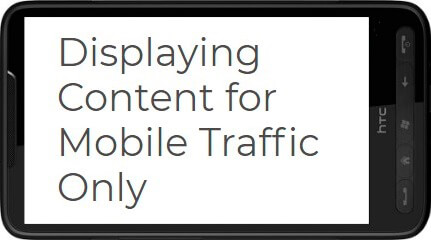Mobile phones are the inherent part of our life. It’s really not an easy thing to find mobile phone without Internet connection. It means that mobile traffic to web-resources increases from year to year. Every web-master is looking forward to attract more users and involve new audience. It’s mistakable to miss such users, so that, we offer to you the solutions of this question.
How to adapt web-content to mobile phones
Mobile visitors are important for each site. Webmasters should attract users from different resources, including mobile-phones. Firstly, we should display a bit differ content for the desktop viewers and the viewers of phones. Some texts or images should be hidden from all except of the mobile-device users; some texts or images contrary should be inserted exclusively for them.
Test the functionality and create your website content
Take the decision on what features you would test the functionality. Think over exactly what your mobile device users would see, what differences should be in the content for the desktop and mobile device users. Here are some ideas for testing: Provide mobile code for the content (e.g. workbooks, Excel templates) not compatible to be downloaded on mobile. It applies to lead generation pages, because even after filling out the forms, such content couldn’t be downloaded on users’ mobile devices. Here are examples of testing: Offer various texts to mobile-device users, that shows that they view the content, using mobile-device and that they could see more information (download some files etc.) if they’ll see the same page on a computer. It’s a good idea to offer them to email the URL of the page to themselves. This will help you to increase mobile conversion. Offer various sizes of images, headers, copies, which are seen only by mobile viewers. It helps to understand, what exactly mobile-users prefer. When you have taken the decision what to test, choose several of your landing pages and insert the materials: texts, images adapted only to mobile version. You should understand that desktop traffic is higher, so it takes more time to receive high mobile traffic.
Choose the material which would be shown and which would be hidden for mobile users
Think over what mobile visitors prefer to see versus desktop visitors. It could be different materials, but whatever you add, should be adapted for them. Suppress the content, which is effective for desktop users, because it doesn’t work for mobile users, such as couldn’t be downloaded to their devices.
Displaying content on mobile devices.
If you eager to insert material only for mobile, you are to add the following code to your web page. Code should be in HTML :
TEXT OR IMAGE SHOWING ONLY FOR MOBILE
The div confirms the copy’s respond only in occasion if the class is triggered. Submitting the code below you may be sure that class is triggered only in one occasion: the viewer comes from mobile-device. The addition of the following code should be in HTML part of the page
Hiding content for mobile devices.
Adding familiar code, as described upper, you could hide any material so that it wouldn’t be displayed on mobile-devices. HTML :
TEXT OR IMAGE HIDING (NOT SHOWING) FOR MOBILE
After this, add the following code to the HTML section:
For applying this styling to web-resource in full, add next code to the CSS stylesheet:
.mobileHide{ display: none;}
Testing mobile codes
Conducting the tests with all sorts of the materials, hiding and inserting them for mobile-users only, we recommend you to check, how it works, visiting your site, using mobile-device. This is important step, because everybody can miss some detail, which spoils the work entirely. After this you may repeat the procedure, but using desktop. Don’t forget that you needn’t hide or show everything in manual way. For example, you can use Data table maker plugin by Supsystic for creating responsive tables, which look differently on computer and on mobile devises. That’s all. Be creative and realize your web ideas with pleasure.
